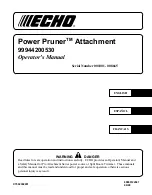
Use
Warning! Let the tool work at its own pace. Do not
overload.
Charging the battery (fig. A)
The battery needs to be charged before first use and
whenever it fails to produce sufficient power on jobs that were
easily done before.
The battery may become warm while charging; this is normal
and does not indicate a problem.
Warning! Do not charge the battery at ambient
temperatures below 10°C or above 40°C. Recommended
charging temperature: approx. 24°C.
Note The charger will not charge a battery if the cell
temperature is below approximately 10°C or above 40°C.
The battery should be left in the charger and the
charger will begin to charge automatically when the cell
temperature warms up or cools down.
• To charge the battery (7), remove it from the tool and
insert it into the charger (8). The battery will only fit into
the charger in one way. Do not force. Be sure that the
battery is fully seated in the charger.
• Plug in the charger and switch on at the mains.
• The charging indicator (9) will illuminate.
The charge is complete when the charging indicator (9) lights
green continuously. The charger and the battery can be left
connected indefinitely with the LED illuminated. The LED
will change to red (charging) state as the charger
occasionally tops off the battery charge. The charging
indicator (9) will be lit as long as the battery is connected to
the plugged-in charger.
• Charge discharged batteries within 1 week. Battery life
will be greatly diminished if stored in a discharged state.
Leaving the battery in the charger
The charger and battery pack can be left connected
indefinitely with the LED lit. The charger will keep the battery
pack fresh and fully charged.
Charger diagnostics
If the charger detects a weak or damaged battery, the
charging indicator (9) will flash red at a fast rate. Proceed as
follows:
• Re-insert the battery (7).
• If the charging indicator continues flashing red at a fast
rate, use a different battery to determine if the charging
process works properly.
• If the replaced battery charges correctly, the original
battery is defective and should be returned to a service
centre for recycling.
• If the new battery gives the same indication as the
original battery, take the charger to be tested at an
authorised service centre.
Note It may take as long as 60 minutes to determine that
the battery is defective.
Switching on and off (fig. E)
For your safety, this tool is equipped with a double switching
system. This system prevents starting the tool inadvertently.
Switching on
• Push the front trigger (16).♦♦
• Push the lock-off button (2) backward using your thumb
and at the same time squeeze the on/off switch (1).
• Release the lock-off button (2).
Switching off
• Release the on/off switch (1).
Warning! Never attempt to lock a switch in the on position.
Hints for optimum use
• Start by trimming the top of the hedge. Slightly tilt the
tool (up to 15° relative to the line of cut) so that the blade
tips point slightly towards the hedge (fig. G1). This will
cause the blades to cut more effectively. Hold the tool at
the desired angle and move it steadily along the line of
cut. The double-sided blade allows you to cut in either
direction.
• In order to obtain a very straight cut, stretch a piece of
string along the length of the hedge at the desired height.
Use the string as a guideline, cutting just above it.
• In order to obtain flat sides, cut upwards with the growth.
Younger stems move outwards when the blade cuts
downwards, causing shallow patches in the hedge (fig. G2).
• Take care to avoid any foreign objects. Especially avoid
hard objects such as metal wire and railings, as these
could damage the blades.
• Regularly oil the blades.
Guidelines for trimming (UK & Ireland)
• Trim hedges and shrubs with seasonal leaves (new
leaves every year) in June and October.
• Trim evergreens in April and August.
• Trim conifers and other fast growing shrubs every six
weeks from May until October.
Guidelines for trimming (Australia & New Zealand)
• Trim hedges and shrubs with seasonal leaves (new
leaves every year) in December and March.
• Trim evergreens in September and February.
• Trim conifers and other fast growing shrubs every six
weeks from October until March.
(Original instructions)
9
ENGLISH
Содержание 22157T
Страница 1: ...www GreenWorksTools com 22157T...
Страница 2: ...2 1 11 3 13 14 16 6 12 15 4 5 7 2 3 4 5 30 0 75...
Страница 3: ...3 1 2 F I...
















































